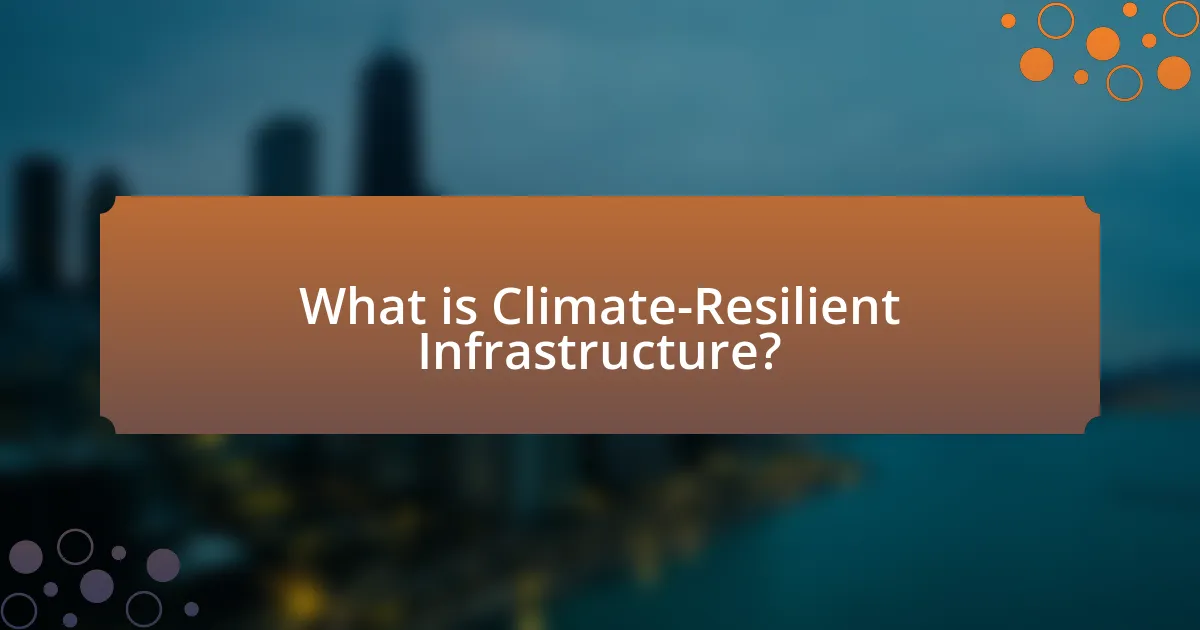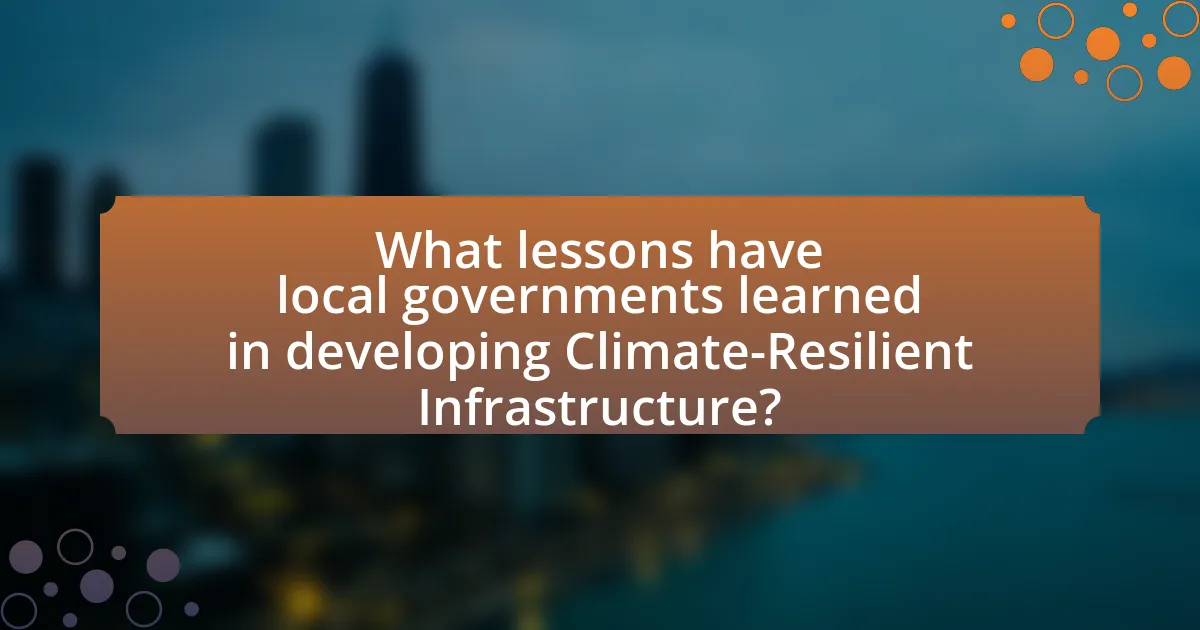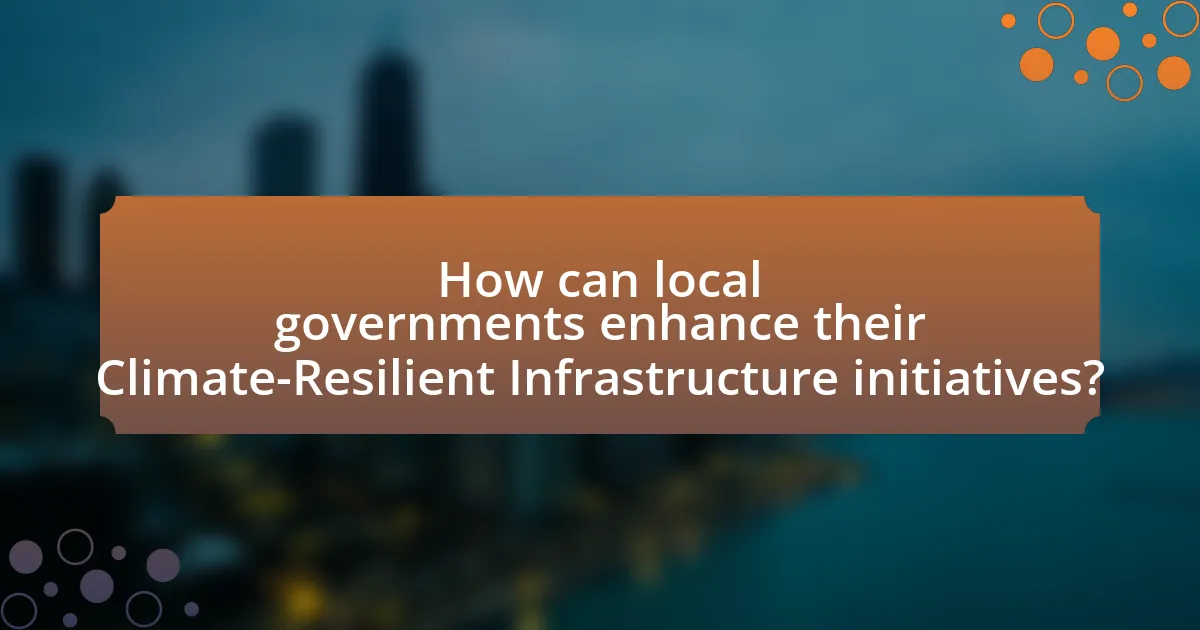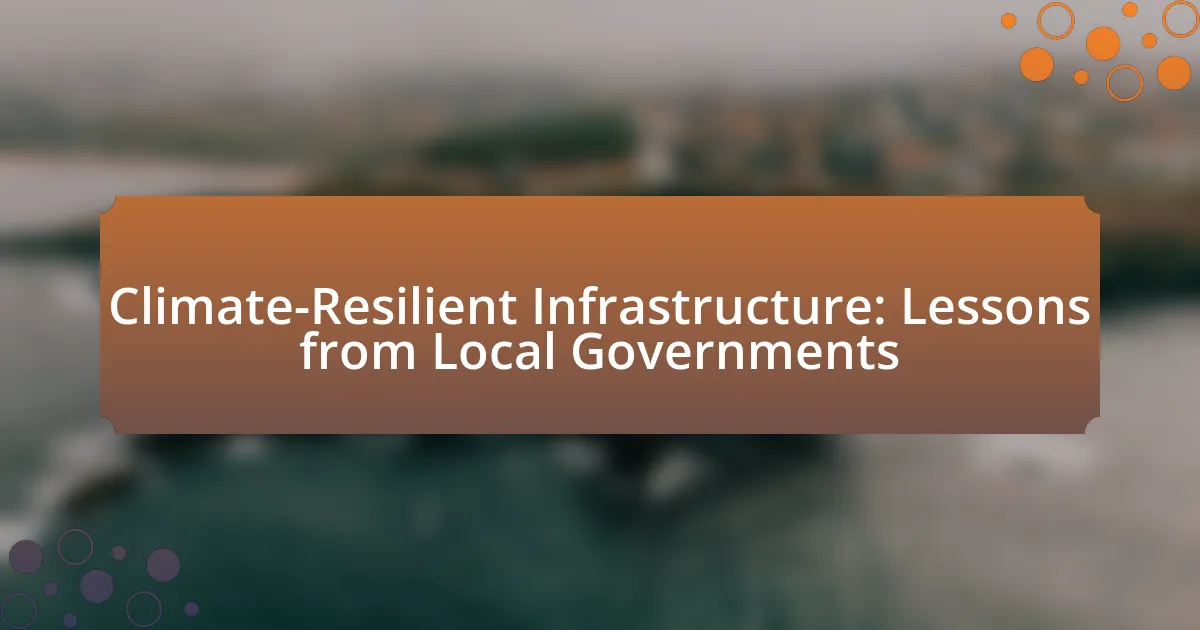Climate-resilient infrastructure encompasses systems and structures specifically designed to endure and adapt to the effects of climate change, including extreme weather and rising sea levels. This article examines the differences between climate-resilient and traditional infrastructure, highlighting key characteristics such as durability, flexibility, and sustainability. It addresses the challenges local governments face in implementing such infrastructure, including financial constraints and the need for community engagement. Additionally, the article explores successful case studies, best practices, and emerging technologies that enhance resilience, while emphasizing the importance of policy reform and proactive planning in developing effective climate-resilient infrastructure initiatives.

What is Climate-Resilient Infrastructure?
Climate-resilient infrastructure refers to systems and structures designed to withstand and adapt to the impacts of climate change, such as extreme weather events, rising sea levels, and temperature fluctuations. This type of infrastructure incorporates materials and technologies that enhance durability and flexibility, ensuring functionality during and after climate-related disruptions. For instance, the American Society of Civil Engineers emphasizes the importance of integrating climate risk assessments into infrastructure planning to mitigate potential damages and enhance community resilience.
How does Climate-Resilient Infrastructure differ from traditional infrastructure?
Climate-resilient infrastructure is designed to withstand and adapt to the impacts of climate change, while traditional infrastructure typically does not account for these future climate risks. Climate-resilient infrastructure incorporates features such as elevated structures, permeable materials, and redundancy in systems to mitigate damage from extreme weather events, whereas traditional infrastructure often relies on standard engineering practices that may not consider changing environmental conditions. For example, a study by the National Institute of Building Sciences found that every dollar invested in disaster mitigation, including climate-resilient infrastructure, can save society an average of six dollars in future disaster costs, highlighting the economic benefits of proactive adaptation compared to reactive traditional approaches.
What are the key characteristics of Climate-Resilient Infrastructure?
Climate-resilient infrastructure is characterized by its ability to withstand and adapt to the impacts of climate change. Key characteristics include durability, which ensures structures can endure extreme weather events; flexibility, allowing for modifications in response to changing conditions; and sustainability, promoting the use of eco-friendly materials and practices. Additionally, climate-resilient infrastructure incorporates advanced technology for monitoring and early warning systems, ensuring proactive responses to climate-related threats. These characteristics are essential for minimizing damage and maintaining functionality during and after climate events, as evidenced by successful implementations in various local government projects worldwide.
Why is Climate-Resilient Infrastructure essential in today’s context?
Climate-resilient infrastructure is essential in today’s context because it mitigates the impacts of climate change, ensuring the safety and sustainability of communities. As extreme weather events increase in frequency and intensity, such as hurricanes, floods, and heatwaves, infrastructure designed to withstand these challenges becomes critical. For instance, the National Oceanic and Atmospheric Administration reported that the U.S. experienced 22 separate billion-dollar weather and climate disasters in 2020 alone. This highlights the urgent need for infrastructure that can adapt to changing conditions, protect lives, and reduce economic losses. By investing in climate-resilient infrastructure, local governments can enhance community resilience, safeguard public health, and promote long-term economic stability.
What are the main challenges faced by local governments in implementing Climate-Resilient Infrastructure?
Local governments face several main challenges in implementing climate-resilient infrastructure, including limited financial resources, lack of technical expertise, and insufficient stakeholder engagement. Financial constraints often hinder the ability to invest in necessary upgrades and maintenance, as many local governments operate under tight budgets. Additionally, the lack of technical expertise can impede the design and execution of effective climate-resilient projects, as specialized knowledge is required to address complex environmental issues. Furthermore, insufficient stakeholder engagement can lead to community resistance and a lack of support for initiatives, making it difficult to achieve consensus on infrastructure projects. These challenges collectively hinder the successful implementation of climate-resilient infrastructure at the local government level.
How do funding and resource allocation impact these challenges?
Funding and resource allocation significantly influence the challenges faced in developing climate-resilient infrastructure. Adequate funding enables local governments to invest in advanced technologies, materials, and training necessary for building infrastructure that can withstand climate-related stresses. For instance, a study by the National Institute of Building Sciences found that every dollar invested in disaster mitigation saves society an average of six dollars in future disaster costs. Conversely, insufficient funding leads to inadequate planning and implementation, resulting in vulnerabilities to climate impacts. This correlation between funding levels and infrastructure resilience underscores the necessity for strategic resource allocation to effectively address climate challenges.
What role does community engagement play in overcoming these challenges?
Community engagement is crucial in overcoming challenges related to climate-resilient infrastructure as it fosters collaboration, enhances local knowledge, and builds trust among stakeholders. Engaging the community allows local governments to gather valuable insights and perspectives that inform decision-making processes, ensuring that infrastructure projects meet the specific needs and concerns of residents. For instance, a study by the National Oceanic and Atmospheric Administration (NOAA) found that communities actively involved in planning and implementing climate adaptation strategies are more likely to support and sustain these initiatives, leading to more effective and resilient outcomes. This collaborative approach not only empowers residents but also increases the likelihood of successful adaptation to climate impacts, demonstrating the significant role of community engagement in addressing infrastructure challenges.

What lessons have local governments learned in developing Climate-Resilient Infrastructure?
Local governments have learned the importance of integrating climate risk assessments into infrastructure planning. This approach enables them to identify vulnerabilities and prioritize investments in resilient systems. For instance, cities like New York have implemented comprehensive climate adaptation strategies, which include elevating infrastructure in flood-prone areas and enhancing stormwater management systems. These strategies are supported by data from the National Oceanic and Atmospheric Administration, which projects increased flooding and extreme weather events due to climate change. Additionally, collaboration with community stakeholders has proven essential, as it ensures that infrastructure projects meet local needs and enhance public support. This lesson is evident in cities like Miami, where community engagement has led to more effective and accepted resilience initiatives.
What successful case studies exist for Climate-Resilient Infrastructure?
Successful case studies for climate-resilient infrastructure include the city of Rotterdam in the Netherlands, which implemented a comprehensive water management system that integrates green roofs, permeable pavements, and water plazas to manage stormwater effectively. This approach has reduced flooding risks and improved urban biodiversity. Another example is New York City, which invested in coastal protection measures post-Hurricane Sandy, including the construction of storm surge barriers and the restoration of wetlands, enhancing the city’s resilience to future storms. These initiatives demonstrate effective strategies for adapting infrastructure to climate change impacts.
How did specific local governments implement effective strategies?
Specific local governments implemented effective strategies by adopting comprehensive climate action plans that integrate resilience measures into infrastructure development. For instance, New York City’s OneNYC initiative focuses on enhancing infrastructure to withstand climate impacts, incorporating green roofs and improved drainage systems to mitigate flooding. Similarly, the city of San Francisco has invested in sea-level rise adaptation projects, such as the Resilient Bay Area program, which emphasizes community engagement and sustainable design practices. These strategies are validated by the successful reduction of vulnerability to climate-related hazards, as evidenced by a 2019 report from the National Oceanic and Atmospheric Administration, which highlighted the effectiveness of such initiatives in urban settings.
What outcomes were achieved from these implementations?
The implementations of climate-resilient infrastructure by local governments achieved significant outcomes, including reduced vulnerability to climate-related hazards and improved community resilience. For instance, cities that invested in green infrastructure, such as permeable pavements and urban forests, reported a decrease in urban flooding by up to 30%, as evidenced by case studies from municipalities like New York and Chicago. Additionally, these initiatives led to enhanced public health outcomes, with a 15% reduction in heat-related illnesses in areas that adopted cooling centers and tree canopies. Overall, these implementations not only mitigated risks associated with climate change but also fostered sustainable urban development.
What best practices can be derived from local governments’ experiences?
Best practices derived from local governments’ experiences in climate-resilient infrastructure include proactive planning, community engagement, and adaptive management. Proactive planning involves integrating climate risk assessments into infrastructure development, ensuring that projects are designed to withstand extreme weather events. For instance, New York City’s use of the Climate Resiliency Design Guidelines has led to infrastructure that can better handle flooding and heatwaves. Community engagement is crucial, as seen in the participatory budgeting initiatives in cities like San Francisco, which empower residents to prioritize climate resilience projects. Adaptive management practices, such as those implemented by the City of Miami, allow for ongoing evaluation and adjustment of strategies based on new climate data and community feedback, ensuring that infrastructure remains effective over time. These practices collectively enhance the resilience of local infrastructure against climate change impacts.
How can local governments foster collaboration with stakeholders?
Local governments can foster collaboration with stakeholders by establishing clear communication channels and engaging in participatory planning processes. Effective communication ensures that stakeholders, including community members, businesses, and non-profits, are informed and can contribute their insights. Participatory planning, as evidenced by successful initiatives in cities like Portland, Oregon, allows stakeholders to actively participate in decision-making, leading to more inclusive and effective climate-resilient infrastructure projects. Research indicates that such collaborative approaches enhance trust and commitment among stakeholders, ultimately resulting in better project outcomes and community support.
What innovative technologies have been utilized in these projects?
Innovative technologies utilized in climate-resilient infrastructure projects include advanced materials, smart sensors, and data analytics platforms. Advanced materials, such as self-healing concrete and permeable pavements, enhance durability and manage stormwater effectively. Smart sensors monitor environmental conditions in real-time, allowing for proactive maintenance and response to climate impacts. Data analytics platforms aggregate and analyze data from various sources, enabling informed decision-making and optimizing resource allocation for infrastructure resilience. These technologies collectively contribute to the development of infrastructure that can withstand and adapt to climate change challenges.

How can local governments enhance their Climate-Resilient Infrastructure initiatives?
Local governments can enhance their Climate-Resilient Infrastructure initiatives by integrating climate risk assessments into urban planning processes. This approach allows for the identification of vulnerabilities in existing infrastructure and the prioritization of investments in resilient solutions. For instance, cities like New York have implemented comprehensive climate action plans that include infrastructure upgrades to withstand extreme weather events, demonstrating the effectiveness of proactive planning. Additionally, local governments can foster partnerships with community stakeholders and private sectors to leverage resources and expertise, as seen in initiatives like the Resilient Cities Network, which promotes collaboration for sustainable urban development.
What strategies can be employed to improve community involvement?
To improve community involvement, local governments can implement strategies such as fostering partnerships with community organizations, conducting regular outreach programs, and utilizing social media for engagement. Research indicates that collaborative efforts with local organizations enhance trust and participation, as seen in the case of the City of Seattle’s partnership with non-profits to promote climate resilience initiatives. Additionally, outreach programs that include workshops and public forums allow residents to voice their concerns and contribute ideas, which has been shown to increase community buy-in for infrastructure projects. Utilizing social media platforms effectively can also reach a broader audience, as evidenced by the success of the City of Boston’s social media campaigns that encouraged public feedback on climate adaptation strategies.
How can education and awareness campaigns support these initiatives?
Education and awareness campaigns can significantly support climate-resilient infrastructure initiatives by informing communities about the importance of sustainable practices and encouraging public participation. These campaigns raise awareness of climate risks and the benefits of resilient infrastructure, leading to increased community engagement and support for local government projects. For instance, a study by the National Oceanic and Atmospheric Administration (NOAA) found that communities with strong educational outreach programs are more likely to adopt climate adaptation strategies, resulting in improved infrastructure resilience. By fostering a well-informed public, these campaigns can drive policy changes and secure funding for climate-resilient projects, ultimately enhancing community preparedness and sustainability.
What role does policy reform play in enhancing infrastructure resilience?
Policy reform plays a critical role in enhancing infrastructure resilience by establishing frameworks that prioritize sustainability and risk management. Effective policy reforms can lead to the integration of climate adaptation strategies into infrastructure planning, ensuring that systems are designed to withstand extreme weather events and other climate-related challenges. For instance, the implementation of updated building codes and land-use regulations can significantly reduce vulnerability to flooding and other hazards, as evidenced by cities that have adopted such measures following severe weather incidents. These reforms not only promote the longevity and reliability of infrastructure but also foster community engagement and investment in resilience initiatives, ultimately leading to safer and more sustainable urban environments.
What are the future trends in Climate-Resilient Infrastructure development?
Future trends in climate-resilient infrastructure development include the integration of nature-based solutions, advanced materials, and smart technology. Nature-based solutions, such as green roofs and urban forests, enhance biodiversity and reduce urban heat, while advanced materials like self-healing concrete improve durability against climate impacts. Smart technology, including IoT sensors, enables real-time monitoring and adaptive management of infrastructure systems, ensuring they can respond effectively to changing environmental conditions. These trends are supported by increasing investments in sustainable infrastructure, with the global green bond market reaching over $1 trillion in 2021, indicating a strong commitment to climate resilience.
How might climate change predictions influence infrastructure planning?
Climate change predictions significantly influence infrastructure planning by necessitating the integration of resilience measures to withstand extreme weather events. Local governments are increasingly using climate models to assess risks such as flooding, heatwaves, and sea-level rise, which directly inform the design and location of infrastructure projects. For instance, the National Oceanic and Atmospheric Administration (NOAA) reports that cities like Miami are adapting their infrastructure to account for projected sea-level rise of up to 6 feet by 2100, leading to elevated roads and improved drainage systems. This proactive approach ensures that infrastructure remains functional and safe in the face of climate-related challenges, ultimately reducing long-term costs and enhancing community resilience.
What emerging technologies could shape the future of Climate-Resilient Infrastructure?
Emerging technologies that could shape the future of climate-resilient infrastructure include advanced materials, smart sensors, and artificial intelligence. Advanced materials, such as self-healing concrete and carbon capture technologies, enhance durability and reduce environmental impact. Smart sensors enable real-time monitoring of infrastructure conditions, allowing for proactive maintenance and disaster response. Artificial intelligence facilitates data analysis for predictive modeling, optimizing resource allocation and improving resilience against climate-related events. These technologies collectively contribute to building infrastructure that can withstand and adapt to changing climate conditions, as evidenced by successful implementations in various urban planning projects worldwide.
What practical steps can local governments take to implement Climate-Resilient Infrastructure effectively?
Local governments can implement climate-resilient infrastructure effectively by conducting comprehensive vulnerability assessments to identify risks and prioritize areas for improvement. These assessments enable local governments to understand specific climate threats, such as flooding or heatwaves, and to tailor infrastructure projects accordingly. For instance, the City of New York’s “OneNYC” plan incorporates climate risk assessments to guide investments in resilient infrastructure, demonstrating a data-driven approach to enhance urban resilience. Additionally, local governments should engage in community consultations to incorporate public input and ensure that infrastructure projects meet the needs of residents. This participatory approach has been shown to increase project acceptance and effectiveness, as seen in the community-driven initiatives in San Francisco. Furthermore, securing funding through state and federal grants, as well as public-private partnerships, can provide the necessary financial resources for implementing these projects. The Federal Emergency Management Agency (FEMA) offers various funding opportunities specifically aimed at enhancing community resilience, which local governments can leverage. Lastly, adopting and enforcing updated building codes and land-use planning that prioritize sustainability and resilience can ensure that new developments are better equipped to withstand climate impacts, as evidenced by the updated codes in Miami-Dade County that require elevated construction in flood-prone areas.
